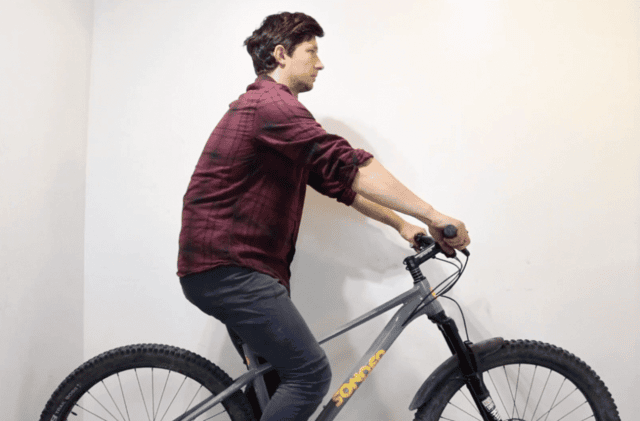Handlebars positioned too close to the front wheel create significant stability and control issues that compromise both comfort and safety. This comprehensive guide explains the causes, consequences, and solutions for correcting improper handlebar positioning to restore optimal bike geometry.
Understanding the Problem: When Handlebars Are Too Close
When your handlebars are positioned too close to the front wheel, you’re experiencing a fundamental bike fit problem that affects multiple aspects of your riding experience. This issue typically stems from having a stem that is too short for your body proportions or bike geometry.
The problem manifests when your handlebars appear to be behind or very close to the front axle when viewed from your riding position. According to bike fitting experts, the optimal position generally places handlebars slightly behind the front hub, creating proper weight distribution and control.

Key Signs Your Handlebars Need Adjustment
Weight distribution issues become apparent when handlebars are improperly positioned. You may notice difficulty maintaining front wheel traction during climbs, unstable handling at speed, or an uncomfortable riding posture that forces you into a cramped position.
The classic handlebar alignment test involves looking down from your riding position – if you can see significant portions of your front wheel hub behind the handlebars, your stem is likely too short. This visual check helps identify when geometry adjustments are necessary.
The Science Behind Proper Handlebar Position
Weight Distribution and Bike Stability
Proper weight distribution between front and rear wheels is crucial for optimal bike performance. When handlebars are too close to the front wheel, it shifts your weight rearward, reducing front wheel traction and compromising steering precision.
Research shows that stem length significantly affects how your weight is distributed over the bike’s contact points. A shorter stem moves your center of gravity backward, while a longer stem shifts weight forward onto the front wheel.
The Physics of Steering Response
Steering geometry changes dramatically with handlebar position. Shorter stems create quicker, more responsive steering that can feel twitchy at speed, while longer stems provide more stable, predictable handling.
The relationship between stem length and handling characteristics is measurable – studies show that reducing stem length by 50mm can increase steering response by 10-17% depending on handlebar width.
Solutions for Correcting Handlebar Position
Stem Length Adjustment
The most effective solution involves installing a longer stem to move handlebars away from the front wheel. Most road bikes perform optimally with stems between 90-130mm, while mountain bikes typically use 35-70mm stems.
Professional bike fitting often reveals that riders need stems 10-30mm longer than their current setup to achieve proper geometry. This adjustment restores optimal reach and weight distribution.
Frame Size Considerations
Sometimes the issue stems from riding a frame that’s too small for your body proportions. When frame reach is insufficient, even the longest practical stem may not provide adequate distance to the handlebars.
Frame geometry analysis should consider both reach and stack measurements. If your current frame requires an extremely long stem (over 140mm) to achieve proper fit, a larger frame size might be the better solution.
Alternative Adjustment Methods
Saddle position adjustments can sometimes help, but moving the saddle forward to compensate for short reach disrupts proper pedaling biomechanics and should be avoided.
Handlebar selection also matters – handlebars with shorter reach measurements can effectively reduce the distance to brake hoods while maintaining proper stem length.
E-Bike Specific Considerations
Comfort-Oriented Geometry
E-bike handlebar positioning typically prioritizes comfort over aerodynamics, with stems ranging from 60-100mm and rise angles of +10° to +20°. This upright position reduces strain during longer rides common with electric bike usage.
E-bike weight distribution requires special consideration due to battery placement and increased overall weight. Proper handlebar position becomes even more critical for maintaining control and stability.
Safety Considerations for Electric Bikes
Higher speeds achievable on e-bikes make proper handlebar positioning essential for safety. Poor geometry that causes instability becomes more dangerous when traveling at 20+ mph.
Motor assistance changes how weight shifts during acceleration and climbing, making proper front-end geometry crucial for maintaining traction and control.

Professional Bike Fitting vs DIY Adjustments
When to Seek Professional Help
Complex geometry issues often require professional analysis to solve properly. Bike fitters use specialized tools and measurement systems to determine optimal positioning for individual body proportions.
Multiple interconnected adjustments may be necessary – changing stem length often requires corresponding saddle position modifications to maintain proper biomechanics.
DIY Adjustment Guidelines
Basic stem replacement can be performed at home with proper tools and torque specifications. Always use manufacturer-recommended torque values to ensure safety.
Incremental changes work best – try adjusting stem length by 10-20mm increments rather than making dramatic changes that require extensive adaptation.
Common Mistakes to Avoid
Over-Adjusting Handlebar Height
Raising handlebars excessively to compensate for short reach creates new problems including reduced front wheel weight and compromised descending position.
Ignoring Overall Bike Geometry
Focusing solely on stem length without considering frame size, saddle position, and handlebar selection often leads to suboptimal results.
Making Multiple Changes Simultaneously
Changing several components at once makes it impossible to determine which adjustment created improvement or problems. Modify one element at a time and test thoroughly.
Long-Term Benefits of Proper Positioning
Enhanced Comfort and Endurance
Correct handlebar positioning reduces strain on arms, shoulders, and back, enabling longer, more comfortable rides without fatigue.
Improved Bike Control
Optimal weight distribution enhances front wheel traction for better climbing performance and cornering confidence.
Predictable steering response results from proper geometry, making bike handling more intuitive and safer at all speeds.
Better Performance Efficiency
Proper positioning allows for more effective power transfer and improved aerodynamics when appropriate for your riding style.
Reduced energy expenditure comes from eliminating the need to constantly adjust position or fight against poor bike geometry during rides.